The Philadelphia Flower Show
 Upon entering the hall, we were greeted by the Floratopia Tree, a large sculpture filled with flowers and plants of every description. Think Rose Bowl Parade float and you’re starting to get the picture. When we looked passed the tree, we could see the exhibits extending off in every direction. Every where you looked there was… wait for it… Rich Planty Goodness. At this point our crew split up to explore the hall individually.
Upon entering the hall, we were greeted by the Floratopia Tree, a large sculpture filled with flowers and plants of every description. Think Rose Bowl Parade float and you’re starting to get the picture. When we looked passed the tree, we could see the exhibits extending off in every direction. Every where you looked there was… wait for it… Rich Planty Goodness. At this point our crew split up to explore the hall individually.I first perused the display gardens, which I had anticipated more than anything else. I tended to gloss over displays that were too “flower arrangement” oriented, such as the Philadelphia Zoo’s giant tiger made of roses, which was an impressive construction, but anticlimactic after the Floratopia tree, and of little interest botanically.
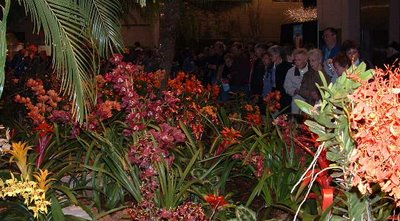 Waldor Orchids had a massive display of color-matched orchids that looked beautiful – they must have had thousands – but there was little botanical information, and the notorious difficulty of re-blooming orchids, I felt there wasn’t much to learn there.
Waldor Orchids had a massive display of color-matched orchids that looked beautiful – they must have had thousands – but there was little botanical information, and the notorious difficulty of re-blooming orchids, I felt there wasn’t much to learn there. J. Franklin Styer was involved in two displays that were very nice but flawed. The “Natura” exhibit was massively scaled sculpture of a goddess/nymph/dryad/whatever, raising out of a mountain, with a tree in one hand and a waterfall in the other. Regrettably, there were individual scenes around her base, all of which seemed to center on flower arrangements… I was quite taken, however, by a small section of the garden, that featured a carpet of pine, which I eventually figured out was dozens of Mugo Pines (Pinus mugo – Pinaceae) all squished together. The second exhibit by Styer was a beautiful woodland walk-through, one of the most naturalistic and convincing gardens in the show. The display featured a wide variety of mature nursery stock, including adult trees and numerous perennials forced into bloom. The garden over all was well-lit, well-labeled, and well laid-out. Unfortunately, it was also well-covered with atrocious fake snow that prevented proper appreciation of the plants.
J. Franklin Styer was involved in two displays that were very nice but flawed. The “Natura” exhibit was massively scaled sculpture of a goddess/nymph/dryad/whatever, raising out of a mountain, with a tree in one hand and a waterfall in the other. Regrettably, there were individual scenes around her base, all of which seemed to center on flower arrangements… I was quite taken, however, by a small section of the garden, that featured a carpet of pine, which I eventually figured out was dozens of Mugo Pines (Pinus mugo – Pinaceae) all squished together. The second exhibit by Styer was a beautiful woodland walk-through, one of the most naturalistic and convincing gardens in the show. The display featured a wide variety of mature nursery stock, including adult trees and numerous perennials forced into bloom. The garden over all was well-lit, well-labeled, and well laid-out. Unfortunately, it was also well-covered with atrocious fake snow that prevented proper appreciation of the plants. Fortunately, there were other impressive displays to look at. Rosade Bonsai Studio had an entire miniature landscape made up of bonsai specimens. I was most taken with a grove planting of Chamaecyparis obtusa (Cupressaceae). I was, however, frustrated by the lack of information commonly given for individual specimens, such as age and length of traing. For that reason I greatly preferred the Bonsai displayed by the Pennsylvania Bonsai Society. They had fewer specimens, but far more info. You could also get much closer to each tree, and better appreciate the minute details. I was most impressed by a Scotch Pine (Pinus sylvestris – Pinaceae) that was 45 years old. I also saw a style I wasn’t familiar with called “Literati” where all the normal bonsai rules go out the window. The Literati style features a long slender trunk that is usually angled, and just a few branches. The example they displayed was a Juniperus chinensis (Cupressaceae).
Fortunately, there were other impressive displays to look at. Rosade Bonsai Studio had an entire miniature landscape made up of bonsai specimens. I was most taken with a grove planting of Chamaecyparis obtusa (Cupressaceae). I was, however, frustrated by the lack of information commonly given for individual specimens, such as age and length of traing. For that reason I greatly preferred the Bonsai displayed by the Pennsylvania Bonsai Society. They had fewer specimens, but far more info. You could also get much closer to each tree, and better appreciate the minute details. I was most impressed by a Scotch Pine (Pinus sylvestris – Pinaceae) that was 45 years old. I also saw a style I wasn’t familiar with called “Literati” where all the normal bonsai rules go out the window. The Literati style features a long slender trunk that is usually angled, and just a few branches. The example they displayed was a Juniperus chinensis (Cupressaceae). A number of groups had displays that were overtly educational. The EPA (I don’t know why, but yeah, the EPA) had a great garden set up that was packed with native plants. I of course was drawn to a merger of two of my interests – two hypertufa troughs planted with Purple and Red Pitcher plants (Sarracenia purpurea, S. rubra – Sarraceniaceae). Delaware Valley College had a display called “Pioneers of Penn’s Woods” featuring detailed histories of early plantsmen. Among the many were Asa Gray, the first professor of botany at Harbard, Carl Linneaus, the father of the modern plant taxonomy, and Nathaniel Ward – the creator of the Wardian Case. Temple University had a walk-through garden featuring medicinal plants with informative handouts. The Williamson Free School did something similar with shoreline environments. The Delaware Valley Chapter of NARGS had a nice trough display with some new uses of hypertufa, including a large bowling ball like sphere with planting pockets formed all over its surface. In another trough, hypertufa spheres were used in place of rocks on the surface. I also really liked the look of three oval pans of different sizes that were stacked. An added pleasure at their display was meeting up with one of the women manning the display that I knew from Mason-Dixon Chapter meetings. She’s an older lady who has been doing alpines for a long time and has many photos in books by Rex Murfitt. Upon learning that I was now an intern at Stonecrop, she and another member said “Oh, you’re one of the lucky few!” I couldn’t agree more…
The Delaware Valley Chapter of NARGS had a nice trough display with some new uses of hypertufa, including a large bowling ball like sphere with planting pockets formed all over its surface. In another trough, hypertufa spheres were used in place of rocks on the surface. I also really liked the look of three oval pans of different sizes that were stacked. An added pleasure at their display was meeting up with one of the women manning the display that I knew from Mason-Dixon Chapter meetings. She’s an older lady who has been doing alpines for a long time and has many photos in books by Rex Murfitt. Upon learning that I was now an intern at Stonecrop, she and another member said “Oh, you’re one of the lucky few!” I couldn’t agree more… There were a number of displays that didn’t necessarily excite me over all, but had fantastic specimens. Burke Brothers had a Euphorbia lacteal ‘Cristata’ (Euphorbaceae) that was so well tucked into the surrounding foliage that I didn’t notice it till the third time I looked at it. Daniel Kepich & Associates had a great collection of azaleas that were at the peak of bloom, but my favorite was the stunning Rhododendron kurume ‘Blauuw’s Pink’ (Ericaceae). Garden Delights had many wonderful specimen succulents. They had massive versions of three houseplants of mine, Haworthia fasciata (Asphodelaceae), Opuntia rufida minima (Cactaceae) and the biggest Pachypodium geayi (Apocynaceae) I have ever seen.
There were a number of displays that didn’t necessarily excite me over all, but had fantastic specimens. Burke Brothers had a Euphorbia lacteal ‘Cristata’ (Euphorbaceae) that was so well tucked into the surrounding foliage that I didn’t notice it till the third time I looked at it. Daniel Kepich & Associates had a great collection of azaleas that were at the peak of bloom, but my favorite was the stunning Rhododendron kurume ‘Blauuw’s Pink’ (Ericaceae). Garden Delights had many wonderful specimen succulents. They had massive versions of three houseplants of mine, Haworthia fasciata (Asphodelaceae), Opuntia rufida minima (Cactaceae) and the biggest Pachypodium geayi (Apocynaceae) I have ever seen.
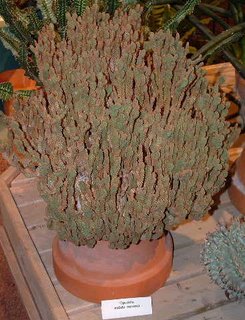
Opuntia rufida minima (Cactaceae)
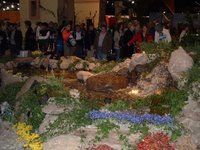 Perhaps the best combination of specimens, landscape, and information was compliments of Jacques Amand Bulb Specialists. They had a lovely little walk-through garden with a naturalistic design and two artful water features. The individual highlights were a mass planting of various Arisaema (Araceae), the stunning yellow and red fringed petals of Tulipa ‘Estella Rijneld’ (Liliaceae), Crocus ‘Zwanenburg Bronze’, and three dwarf Iris, Iris reticulata ‘Cantab’, I. reticulata ‘Marguerite’ and Iris ‘Danforidae’ (Iridaceae).
Perhaps the best combination of specimens, landscape, and information was compliments of Jacques Amand Bulb Specialists. They had a lovely little walk-through garden with a naturalistic design and two artful water features. The individual highlights were a mass planting of various Arisaema (Araceae), the stunning yellow and red fringed petals of Tulipa ‘Estella Rijneld’ (Liliaceae), Crocus ‘Zwanenburg Bronze’, and three dwarf Iris, Iris reticulata ‘Cantab’, I. reticulata ‘Marguerite’ and Iris ‘Danforidae’ (Iridaceae).
 Tulipa ‘Estella Rijneld’ (Liliaceae)
Tulipa ‘Estella Rijneld’ (Liliaceae)

Crocus ‘Zwanenburg Bronze’ (Iridaceae)
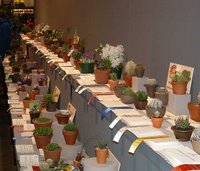 Something exciting at the Philadelphia show that was absent from my experiences with the Maryland Home and Garden show was the presence of competitively judged plants. There were hundreds of beautiful specimens of bulbs, succulents, dish gardens, topiaries, foliage plants… the list goes on.
Something exciting at the Philadelphia show that was absent from my experiences with the Maryland Home and Garden show was the presence of competitively judged plants. There were hundreds of beautiful specimens of bulbs, succulents, dish gardens, topiaries, foliage plants… the list goes on.I saw the most plants that I liked amongst the succulents, including Monathes polyphylla (Crassulaceae), Mammillaria bocasana (Cactaceae), Sedum compactum (Crassulaceae) and the very odd cone-shape of Pseudolithos migutinos (Asclepiadaceae). Caroline pointed out a fine Astrophytum myriostigma v. nudum (Cactaceae) that she had judged. I also liked the Euphorbia decaryi spirosticha (Euphorbaceae), which looked like it was dead, the Haworthia truncata (Asphodelaceae) that looked like a stack of dark celery stalks, and the blue-ribbon winning Conophytum obcordellum (Aizoaceae) that looked like a clump of mushed-together Lithops (living stones).
 Conophytum obcordellum (Aizoaceae)
Conophytum obcordellum (Aizoaceae)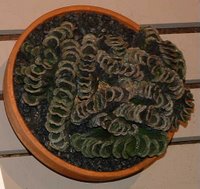 Haworthia truncata (Asphodelaceae)
Haworthia truncata (Asphodelaceae) There were a number of flowers I quite liked. Scilla mischteschenkoana (Liliaceae) had big clumps of beautiful white flowers. I also liked tiny Primula allionii ‘Anna Griffith’, Tulipa ‘Coleur Cardinal’ (Liliaceae) and the orchid-like markings on Iris ‘Katharine Hodgkin’ (Iridaceae). Great foliage plants included tiny, ten-year old Abies balsamea ‘Jami’ (Pinaceae), Trillium underwoodii (Trilliaceae), Dasylirion longissumum (Agavaceae) and the spiral foliage of Beaucarnea recurvata (Agavaceae).
There were a number of flowers I quite liked. Scilla mischteschenkoana (Liliaceae) had big clumps of beautiful white flowers. I also liked tiny Primula allionii ‘Anna Griffith’, Tulipa ‘Coleur Cardinal’ (Liliaceae) and the orchid-like markings on Iris ‘Katharine Hodgkin’ (Iridaceae). Great foliage plants included tiny, ten-year old Abies balsamea ‘Jami’ (Pinaceae), Trillium underwoodii (Trilliaceae), Dasylirion longissumum (Agavaceae) and the spiral foliage of Beaucarnea recurvata (Agavaceae).Several other judged contestants that caught my eye were the minature gardens, which made all of us start planning a miniature Stonecrop garden. There were also a large number of terrariums and Wardian cases (Wardian cases are miniature glasshouses). We were all struck by the well-planted globe terrariums entered by one Martha Miller, whom I will be contacting to find out how she got her glass so clean…
The only frustration of the judged contestants was seeing how many award-winning entries there were from Mrs. “Dodo” Hamilton, a wealthy Philadelphia area heiress with a passion for gardening. I admire her work, but this woman is the prototypical curve-blower, winning awards in almost every category. Seriously, she probably went home with 1/3 of all the ribbons that were given. It hardly seemed fair, even though her stuff was great. I even overheard two little old ladies discussing it – one of them said to the other rather acidly “Read in your head. If I hear you say “Mrs. Hamilton” one more time I’m going to punch you”! Those wacky senior citizens…
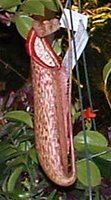 At last we came to the instant gratification part of the show… blowing our hard-earned cash at the many sales booths. I was wowed by the overwhelming numbers and variety of plants for sale. While I was very tempted by the tropical pitcher plant Nepenthes x Miranda (Nepenthaceae), I managed to escape with less than $40 in purchases (Didn’t I just get finished giving all my plants away?!?), spending it at Meehan’s Miniatures (a MD bonsai company) and Desertlands – succulent specialists. Martha sold me three tiny bonsai pots, Scirpus cirnuus (Cyperaceae), Selaginella emmeliana (Sellaginaceae), Crassula portulaceae (Crassulaceae) and Sagina subulata (Caryophyllaceae). Desertlands sold me three tiny succulents that I have not yet conclusively identified and a very cool Euphorbia obesa (Euphorbaceae) – aka Baseball plant.
At last we came to the instant gratification part of the show… blowing our hard-earned cash at the many sales booths. I was wowed by the overwhelming numbers and variety of plants for sale. While I was very tempted by the tropical pitcher plant Nepenthes x Miranda (Nepenthaceae), I managed to escape with less than $40 in purchases (Didn’t I just get finished giving all my plants away?!?), spending it at Meehan’s Miniatures (a MD bonsai company) and Desertlands – succulent specialists. Martha sold me three tiny bonsai pots, Scirpus cirnuus (Cyperaceae), Selaginella emmeliana (Sellaginaceae), Crassula portulaceae (Crassulaceae) and Sagina subulata (Caryophyllaceae). Desertlands sold me three tiny succulents that I have not yet conclusively identified and a very cool Euphorbia obesa (Euphorbaceae) – aka Baseball plant. 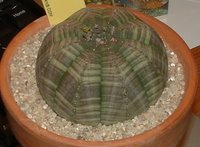
Euphorbia obesa (Euphorbaceae)
After a long day it was time to grab some more comfort food from Reading Market, and pack into the car for a game of “Capability Brown” on the way back to Stonecrop. Overall, it was a great experience. While I was at first a bit disappointed by the show (due to unrealistically high expectations – I had always been told the Philly show was 10 times better than the MD show – it’s only twice as good), I quickly fell under it’s spell and had a great time. While I would have liked to see more displays with an emphasis on practical and realistic landscapes, and fewer with exploding mudpot geysers, fake snow and inexplicably, dryer vents, I was blown away by the number and quality of specimen plants being judged, displayed, and sold. I’ll definitely go again in the future, and recommend that you check it out if you ever get the chance.
Wow. Longest post I’ve ever done*. Stay tuned, there will be more field trips, more sights of Stonecrop, and I will probably begin featuring some of my Plants of the Day.
*Full Disclosure: This post is, in fact, adapted from the essay I wrote for Stonecrop about the field trip. The post is a little more fluffy, the essay was a bit “heavy on the sausage”, to use Caroline’s expression. Does it still qualify as longest post ever?

1 Comments:
Longest post ever, essay or no.
Was "Harbard" a typo? If so, vaguely funny.
Otherwise, you are sounding amazing, astoundingly, happily *lucid*, thinking, considering, observing, learning, and savoring the experience.
When I lived in Filthydelphia, I went to the flower show a couple of times, an experience I have to admit that, at the time (age 11 or so) I more endured than enjoyed.
Consider my eyes opened.
While you approach your trip with an enthusiast's eye, though clearly no longer one of a casual hobbyist, it's always marvelous to hear such passion in a friend's voice, especially when previous emotion had only been provoked by egregious Republican dastardliness.
I was especially taken by your description of the succulents, clearly your longstanding favorite (perhaps because "succulent" is generally such a tasty word to say and apply?), coupled with pictures of the decidedly odd and beautiful little creatures.
It was also more than a little humorous to hear about the wee old lady who took the bulk of the awards - the conversation was priceless! I wonder: does greenhouse envy exist?
SO good to hear you're thriving, bud.
Or would that be....budding?
Post a Comment
<< Home